| |
Scalable Computing journal
Scalable Computing Lab
Technical Committee on Scalable Computing
|
|
 |
 |
What is
Scalable Computing?
Scalable computing involves using a computer system that can adapt
to the need for more powerful computing capabilities. Scalability
is also a desirable quality for a network, process, website, or
business model. In terms of hardware, a scalable computer system
may begin with one node, but more nodes can be added as and when
there is a need for more computing capabilities.
When sold with IT equipment or software itís sold as a feature to
convince high growth businesses that their future needs can be
accommodated easily and without recourse to expensive machine
replacement or staff retraining.
Geographical spread. A scalable system need not be at one physical
address. The easy availability of high-speed networks and powerful
computers has led to the emergence of two computing trends:
cluster computing and grid computing. Geographically remote
desktop computers, storage systems, data sources, scientific
instruments and clusters can be combined into what are known as
computational grids. Highly scalable storage and computing
capabilities can be spread over a wide geographical area and, in
fact, across countries and continents.
Clusters of workstations connected by a LAN allow flexibility, low
cost and easy scaling.
Example uses: Data warehousing. Scalability of computer
architecture is one of the most important considerations when
designing and deploying a data warehousing computer network.

|
|
- Industry Standards
-
Scalable programming languages |
